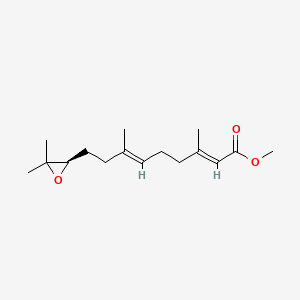| MeSH term | MeSH ID | Detail |
|---|---|---|
| Starvation | D013217 | 47 associated lipids |
Juvenile hormone III
Juvenile hormone iii is a lipid of Prenol Lipids (PR) class. Juvenile hormone iii is associated with abnormalities such as Wiskott-Aldrich Syndrome. The involved functions are known as pheromone biosynthetic process.
Cross Reference
Introduction
To understand associated biological information of Juvenile hormone III, we collected biological information of abnormalities, associated pathways, cellular/molecular locations, biological functions, related genes/proteins, lipids and common seen animal/experimental models with organized paragraphs from literatures.
What diseases are associated with Juvenile hormone III?
Juvenile hormone III is suspected in and other diseases in descending order of the highest number of associated sentences.
Related references are mostly published in these journals:
| Disease | Cross reference | Weighted score | Related literature |
|---|
Possible diseases from mapped MeSH terms on references
We collected disease MeSH terms mapped to the references associated with Juvenile hormone III
PubChem Associated disorders and diseases
What pathways are associated with Juvenile hormone III
Lipid pathways are not clear in current pathway databases. We organized associated pathways with Juvenile hormone III through full-text articles, including metabolic pathways or pathways of biological mechanisms.
Related references are published most in these journals:
| Pathway name | Related literatures |
|---|
PubChem Biomolecular Interactions and Pathways
Link to PubChem Biomolecular Interactions and PathwaysWhat cellular locations are associated with Juvenile hormone III?
There are no associated biomedical information in the current reference collection.
What functions are associated with Juvenile hormone III?
Related references are published most in these journals:
| Function | Cross reference | Weighted score | Related literatures |
|---|
What lipids are associated with Juvenile hormone III?
There are no associated biomedical information in the current reference collection.
What genes are associated with Juvenile hormone III?
There are no associated biomedical information in the current reference collection.
What common seen animal models are associated with Juvenile hormone III?
There are no associated biomedical information in the current reference collection.
NCBI Entrez Crosslinks
All references with Juvenile hormone III
Download all related citations| Authors | Title | Published | Journal | PubMed Link |
|---|---|---|---|---|
| Lengyel F et al. | Juvenile hormone III influences task-specific cuticular hydrocarbon profile changes in the ant Myrmicaria eumenoides. | 2007 | J. Chem. Ecol. | pmid:17146723 |
| Chou SY et al. | Antenna contact and agonism in the male lobster cockroach, Nauphoeta cinerea. | 2007 | Horm Behav | pmid:17574250 |
| Ichikawa A et al. | Enantioselective separation of racemic juvenile hormone III by normal-phase high-performance liquid chromatography and preparation of [(2)H(3)]juvenile hormone III as an internal standard for liquid chromatography-mass spectrometry quantification. | 2007 | J Chromatogr A | pmid:17582423 |
| Yu YS et al. | Distribution of imidacloprid residues in different parts of rice plants and its effect on larvae and adult females of Chilo suppressalis (Lepidoptera: Pyralidae). | 2007 | J. Econ. Entomol. | pmid:17461061 |
| Jones D and Jones G | Farnesoid secretions of dipteran ring glands: what we do know and what we can know. | 2007 | Insect Biochem. Mol. Biol. | pmid:17628277 |
| Chen Z et al. | Comparison of radioimmunoassay and liquid chromatography tandem mass spectrometry for determination of juvenile hormone titers. | 2007 | Insect Biochem. Mol. Biol. | pmid:17628278 |
| Vyazunova I et al. | Identification of two sterol carrier protein-2 like genes in the yellow fever mosquito, Aedes aegypti. | 2007 | Insect Mol. Biol. | pmid:17433070 |
| Schwartzberg EG et al. | Juvenile hormone titres and winged offspring production do not correlate in the pea aphid, Acyrthosiphon pisum. | 2008 | J. Insect Physiol. | pmid:18634797 |
| Kou R et al. | Juvenile hormone levels are increased in winners of cockroach fights. | 2008 | Horm Behav | pmid:18656865 |
| Kou R et al. | Pheromone, juvenile hormone, and social status in the male lobster cockroach Nauphoeta cinerea. | 2008 | Arch. Insect Biochem. Physiol. | pmid:18454486 |
| Raina A et al. | Molting in workers of the Formosan subterranean termite Coptotermes formosanus. | 2008 | J. Insect Physiol. | pmid:17904575 |
| Vieira CU et al. | Farnesoic acid O-methyl transferase (FAMeT) isoforms: conserved traits and gene expression patterns related to caste differentiation in the stingless bee, Melipona scutellaris. | 2008 | Arch. Insect Biochem. Physiol. | pmid:18076110 |
| Bearfield JC et al. | Isolation, endocrine regulation and transcript distribution of a putative primary JH-responsive gene from the pine engraver, Ips pini (Coleoptera: Scolytidae). | 2008 | Insect Biochem. Mol. Biol. | pmid:18207085 |
| Parthasarathy R and Palli SR | Proliferation and differentiation of intestinal stem cells during metamorphosis of the red flour beetle, Tribolium castaneum. | 2008 | Dev. Dyn. | pmid:18297733 |
| Mayoral JG et al. | NADP+-dependent farnesol dehydrogenase, a corpora allata enzyme involved in juvenile hormone synthesis. | 2009 | Proc. Natl. Acad. Sci. U.S.A. | pmid:19940247 |
| Miyazaki M et al. | Liquid chromatography-electrospray ionization-mass spectrometric quantitation of juvenile hormone III in whole body extracts of the Formosan subterranean termite. | 2009 | J. Chromatogr. B Analyt. Technol. Biomed. Life Sci. | pmid:19729350 |
| Velarde RA et al. | Coordinated responses to developmental hormones in the Kenyon cells of the adult worker honey bee brain (Apis mellifera L.). | 2009 | J. Insect Physiol. | pmid:19013465 |
| Bearfield JC et al. | Two regulatory mechanisms of monoterpenoid pheromone production in Ips spp. of bark beetles. | 2009 | J. Chem. Ecol. | pmid:19554371 |
| Wang J et al. | Juvenile hormone regulation of Drosophila Epac--a guanine nucleotide exchange factor. | 2009 | Mol. Cell. Endocrinol. | pmid:19433259 |
| Tian L et al. | Juvenile hormone III produced in male accessory glands of the longhorned beetle, Apriona germari, is transferred to female ovaries during copulation. | 2010 | Arch. Insect Biochem. Physiol. | pmid:20734418 |
